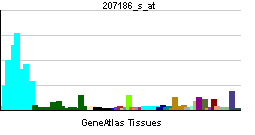BPTF
| Bromodomain PHD finger transcription factor | |||||||||||||
|---|---|---|---|---|---|---|---|---|---|---|---|---|---|
 PDB rendering based on 2f6j. | |||||||||||||
| |||||||||||||
| Identifiers | |||||||||||||
| Symbols | BPTF ; FAC1; FALZ; NURF301 | ||||||||||||
| External IDs | Template:OMIM5 Template:MGI HomoloGene: 83195 | ||||||||||||
| |||||||||||||
| RNA expression pattern | |||||||||||||
 | |||||||||||||
 | |||||||||||||
| More reference expression data | |||||||||||||
| Orthologs | |||||||||||||
| Template:GNF Ortholog box | |||||||||||||
| Species | Human | Mouse | |||||||||||
| Entrez | n/a | n/a | |||||||||||
| Ensembl | n/a | n/a | |||||||||||
| UniProt | n/a | n/a | |||||||||||
| RefSeq (mRNA) | n/a | n/a | |||||||||||
| RefSeq (protein) | n/a | n/a | |||||||||||
| Location (UCSC) | n/a | n/a | |||||||||||
| PubMed search | n/a | n/a | |||||||||||
Bromodomain PHD finger transcription factor, also known as BPTF, is a human gene.[1]
This gene was identified by the reactivity of its encoded protein to a monoclonal antibody prepared against brain homogenates from patients with Alzheimer's disease. Analysis of the original protein (fetal Alz-50 reactive clone 1, or FAC1), identified as an 810 aa protein containing a DNA-binding domain and a zinc finger motif, suggested it might play a role in the regulation of transcription. High levels of FAC1 were detected in fetal brain and in patients with neurodegenerative diseases. The protein encoded by this gene is actually much larger than originally thought, and it also contains a C-terminal bromodomain characteristic of proteins that regulate transcription during proliferation. The encoded protein is highly similar to the largest subunit of the Drosophila NURF (nucleosome remodeling factor) complex. In Drosophila, the NURF complex, which catalyzes nucleosome sliding on DNA and interacts with sequence-specific transcription factors, is necessary for the chromatin remodeling required for transcription. Two alternative transcripts encoding different isoforms have been described completely.[1]
References
Further reading
- Bowser R, Giambrone A, Davies P (1995). "FAC1, a novel gene identified with the monoclonal antibody Alz50, is developmentally regulated in human brain". Dev. Neurosci. 17 (1): 20–37. PMID 7621746.
- Bonaldo MF, Lennon G, Soares MB (1997). "Normalization and subtraction: two approaches to facilitate gene discovery". Genome Res. 6 (9): 791–806. PMID 8889548.
- Zhu P, Bowser R (1997). "Identification and analysis of the complete cDNA sequence for the human FAC1 gene". Biochim. Biophys. Acta. 1309 (1–2): 5–8. PMID 8950167.
- Bowser R (1997). "Assignment of the human FAC1 gene to chromosome 17q24 by fluorescence in situ hybridization". Genomics. 38 (3): 455–7. doi:10.1006/geno.1996.0657. PMID 8975731.
- Mu X, Springer JE, Bowser R (1997). "FAC1 expression and localization in motor neurons of developing, adult, and amyotrophic lateral sclerosis spinal cord". Exp. Neurol. 146 (1): 17–24. doi:10.1006/exnr.1997.6508. PMID 9225734.
- Jordan-Sciutto KL, Dragich JM, Bowser R (1999). "DNA binding activity of the fetal Alz-50 clone 1 (FAC1) protein is enhanced by phosphorylation". Biochem. Biophys. Res. Commun. 260 (3): 785–9. doi:10.1006/bbrc.1999.0986. PMID 10403843.
- Jordan-Sciutto KL, Dragich JM, Rhodes JL, Bowser R (2000). "Fetal Alz-50 clone 1, a novel zinc finger protein, binds a specific DNA sequence and acts as a transcriptional regulator". J. Biol. Chem. 274 (49): 35262–8. PMID 10575013.
- Jones MH, Hamana N, Shimane M (2000). "Identification and characterization of BPTF, a novel bromodomain transcription factor". Genomics. 63 (1): 35–9. doi:10.1006/geno.1999.6070. PMID 10662542.
- Jordan-Sciutto KL, Dragich JM, Caltagarone J; et al. (2000). "Fetal Alz-50 clone 1 (FAC1) protein interacts with the Myc-associated zinc finger protein (ZF87/MAZ) and alters its transcriptional activity". Biochemistry. 39 (12): 3206–15. PMID 10727212.
- Jordan-Sciutto K, Rhodes J, Bowser R (2002). "Altered subcellular distribution of transcriptional regulators in response to Abeta peptide and during Alzheimer's disease". Mech. Ageing Dev. 123 (1): 11–20. PMID 11640947.
- Strausberg RL, Feingold EA, Grouse LH; et al. (2003). "Generation and initial analysis of more than 15,000 full-length human and mouse cDNA sequences". Proc. Natl. Acad. Sci. U.S.A. 99 (26): 16899–903. doi:10.1073/pnas.242603899. PMID 12477932.
- Rhodes J, Lutka FA, Jordan-Sciutto KL, Bowser R (2003). "Altered expression and distribution of FAC1 during NGF-induced neurite outgrowth of PC12 cells". Neuroreport. 14 (3): 449–52. doi:10.1097/01.wnr.0000059782.23521.35. PMID 12634501.
- Barak O, Lazzaro MA, Lane WS; et al. (2004). "Isolation of human NURF: a regulator of Engrailed gene expression". EMBO J. 22 (22): 6089–100. doi:10.1093/emboj/cdg582. PMID 14609955.
- Ota T, Suzuki Y, Nishikawa T; et al. (2004). "Complete sequencing and characterization of 21,243 full-length human cDNAs". Nat. Genet. 36 (1): 40–5. doi:10.1038/ng1285. PMID 14702039.
- Beausoleil SA, Jedrychowski M, Schwartz D; et al. (2004). "Large-scale characterization of HeLa cell nuclear phosphoproteins". Proc. Natl. Acad. Sci. U.S.A. 101 (33): 12130–5. doi:10.1073/pnas.0404720101. PMID 15302935.
- Strachan GD, Morgan KL, Otis LL; et al. (2004). "Fetal Alz-50 clone 1 interacts with the human orthologue of the Kelch-like Ech-associated protein". Biochemistry. 43 (38): 12113–22. doi:10.1021/bi0494166. PMID 15379550.
- Gerhard DS, Wagner L, Feingold EA; et al. (2004). "The status, quality, and expansion of the NIH full-length cDNA project: the Mammalian Gene Collection (MGC)". Genome Res. 14 (10B): 2121–7. doi:10.1101/gr.2596504. PMID 15489334.
- Strachan GD, Ostrow LA, Jordan-Sciutto KL (2005). "Expression of the fetal Alz-50 clone 1 protein induces apoptotic cell death". Biochem. Biophys. Res. Commun. 336 (2): 490–5. doi:10.1016/j.bbrc.2005.08.127. PMID 16137655.
- Wysocka J, Swigut T, Xiao H; et al. (2006). "A PHD finger of NURF couples histone H3 lysine 4 trimethylation with chromatin remodelling". Nature. 442 (7098): 86–90. doi:10.1038/nature04815. PMID 16728976.
- Li H, Ilin S, Wang W; et al. (2006). "Molecular basis for site-specific read-out of histone H3K4me3 by the BPTF PHD finger of NURF". Nature. 442 (7098): 91–5. doi:10.1038/nature04802. PMID 16728978.
| This protein-related article is a stub. You can help Wikipedia by expanding it. |